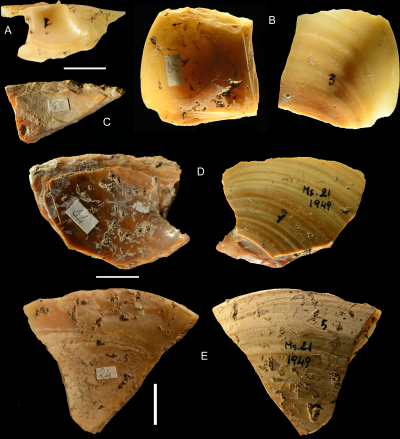|
Remember that ticked-off world traveler – carrying his squash racquet, of course -- doing a double-take at the airport commercial? “So easy a caveman can do it?” That got his attention. Caveman/Neanderthal. The terms blur in modern usage, but either way, the passenger takes exception to his ancestors being used in a derogatory fashion. And he has a point. A lot of contemporary “humans” carry vestiges of Neanderthal genes, from quickie hookups back in the day. The more I read about Neanderthals, the more I think this is something to brag about. Some people have the random 1 percent – meaning they are descendants of a race that ran in family packs, began to use some of the world’s natural goods, was able to improvise. (Friend of ours has a smidgen of Neanderthal, DNA -- and that lady is a lawyer.)  Ancient Neanderthal tools. Thanks to Science/Alert for article two weeks ago. Ancient Neanderthal tools. Thanks to Science/Alert for article two weeks ago. The latest discovery of Neanderthal accomplishment was by scientists who found sharpened shells in ancient ponds in Italy, meaning Neanderthals were able to dive in water over their heads, and fashion shells into cutting tools and spears for hunting. The research was written up in the Times in this week’s Tuesday Science Section, although the essence had already been posted on the Web: https://www.sciencealert.com/some-neanderthals-swam-and-dove-for-shells-to-use-as-tools-research-suggests I have been fascinated by Neanderthals since I read the article by Carl Zimmer in the NYT Magazine in February of 2018, describing the talents and range of Neanderthals before they ran out of space and time, losing out to vastly superior homo sapiens. As a journalist, I was hooked by Zimmer’s lead: "It’s long been an insult to be called a Neanderthal. But the more these elusive, vanished people have been studied, the more respect they’ve gained among scientists." https://www.nytimes.com/2018/02/22/science/neanderthals-cave-paintings-europe.html That NYT article prompted me to read “Who We Are and How We Got Here: Ancient DNA and the New Science of the Human Past,” by David Reich. (Pantheon.) Here I learned about the species called Denisovans.  A Google search revealed a trove of contemporary forensic constructions of Neanderthals, many of them looking like faces you could see around the world. https://www.google.com/search?q=photo+image+Neanderthal+woman&tbm=isch&ved=2ahUKEwip7riFhKnnAhVED98KHcTTBEkQ2-cCegQIABAA&oq=photo+image+Neanderthal+woman&gs_l=img.3...54110.56303..57092...0.0..0.77.592.9......0....1..gws-wiz-img.10atzNnjo8c&ei=M5gxXumIOMSe_AbEp5PIBA&bih=576&biw=1366&rlz=1C1GCEA_enUS874US874 As for the irate dude with the squash racquet, he has made a recent comeback in other Geico commercials, still feeling slighted by modern society, where superior homo sapiens can learn and remember and reason. (Wonder what he thinks, watching the impeachment “trial.”) * * * (The music on the commercial: "Remind Me," by the very modern Norwegian duo, Royksopp.) (https://royksopp.com/
Randolph
1/29/2020 04:15:49 pm
George,
George
1/29/2020 04:45:00 pm
Randy: I could reply with the words of Casey Stengel, whom I covered from 1962-65, when he managed the Hideous Mets. His comment often was: "I seen what they done."
bruce
1/31/2020 05:23:34 pm
george,
George
1/31/2020 10:20:07 pm
Bruce: my wife has been doing genealogy studies of her family — Normans, Scots, Welsh, lot
bruce
2/2/2020 12:53:52 pm
george, Comments are closed.
|
Categories
All
|









